| 1000-Level | ....... | 2000-Level | ....... | 3000-Level | ....... | 4000-Level |
This course has been renamed MATH 3770H[307H] , and moved to the Fall semester.
This course has been renamed MATH-PHYS 3160H[303H]
This course has been renamed MATH-PHYS 3140H[314H]
This course has been renamed MATH-PHYS 3130H[313H]
Synopsis: We'll focus on the following topics:
|
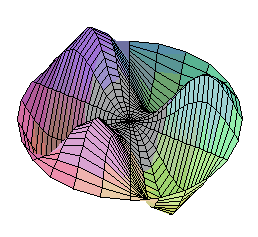 The Wave Equation: A vibrational mode of a circular membrane. |
|
Overview: Partial differential equations (PDEs) model physical systems which evolve continuously in time, and whose physical state is described by some continuous function in space. For example, suppose we pour some ink into a flat tray of water. Let p(x,y;t) describe the concentration of ink in the tray at spatial coordinates (x,y) and time t. Then the ink obeys the Heat Equation:
|
PDEs are ubiquitous in applied mathematics. For example:
Given a PDE we can ask four questions:
|
(formerly Math 308H)
Differential equations in applied mathematics, including Bessel, Legendre, hypergeometric, Laguerre, Hermite, Chebyshev, etc. Series and numerical solutions. Properties of the special functions arising from these equations.
- Prerequisite: MATH-PHYS 2150H[205H] .
- Meetings: Three lectures and one tutorial weekly.
- Class Timetable: Winter
- Instructor: Xiaorang Li
- For more information, please see the MATH 3160H homepage.
Applied mathematics as found in the classical mechanics of particles. One-dimensional motion, vector differential operators, three-dimensional motion, moving and rotating coordinate systems, central forces, systems of particles.
- Prerequisites: MATH 1100[110] and Physics 100 or permission of the instructor.
- Pre or co-orequisite: MATH 2110H[201H] .
- Meetings: Three lectures and tutorial weekly.
- Class timetable
- Taught by the Department of Physics.
Applied mathematics as found in the classical mechanics of particles, rigid bodies and continuous media. Motion of rigid bodies, Lagrangian mechanics, Hamiltonian mechanics, dynamics of oscillating systems.
- Prerequisites: MATH 2110H[201H] , and also MATH-PHYS 2150H[205H] and Mathematics-Physics 312H or 313H.
- Meetings: Three class meetings weekly.
- Class timetable
- Taught by the Department of Physics.
Overview: Number theory is one of the oldest and richest areas of mathematics, and ubiquitous in contemporary mathematical research. We will likely examine the following topics: | 
The Lattice of Divisibility of integers. | |
| ||
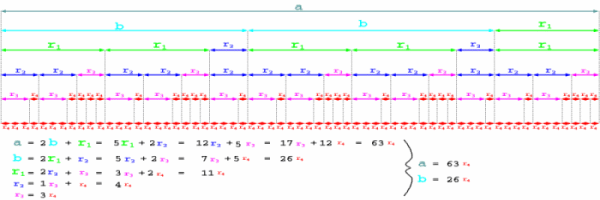
The Euclidean algorithm is a method to compute the greatest common divisor of two numbers. | ||
Description: Cryptography is an area of large and growing importance in modern communication networks, especially in areas of computer security and electronic commerce. Knowledge of this cryptography is thus important to computer science or math students who wish to develop marketable skills for employment in industry. Mathematical cryptography is also an important area of contemporary mathematical research (it is the major application area of modern number theory), and is relevant to any student entering graduate studies in Pure Mathematics or Theoretical Computer Science.
Many encryption systems are based on number theory; the difficulty in breaking these encryption schemes is essentially the difficulty of solving certain hard number theory problems. For example, the RSA public-key cryptosystem is based on the problem of prime factorization (so an efficient factorization algorithm would break RSA encryption). Because of this, advanced number theory is relevant both for breaking existing cryptosystems, and designing new ones which are provably resistant to attack. We will discuss applications of number theory to cryptography, including the RSA and el Gamal public key cryptosystems, and the computational problems of efficiently generating large primes and finding prime factorizations.
Rough Syllabus:
Introduction to cryptography: Basic terminology (`plaintext', `ciphertext', `cryptosystem', `key'. etc.) Kerkhoff's principle. `Hard' vs. `easy' computational problems (big `O' estimates of computational complexity). Public-key vs. private key cyptography.
Classical Cryptosystems: Shift ciphers. Substitution ciphers. affine ciphers, Vigenère cipher.
Shannon's Theory: Information theory. Perfect secrecy. Unicity distance.
Modular Arithmetic: The ring structure of Zm. Solution of linear congruences. Fermat's little theorem. Euler's theorem.
Modular Arithmetic: The Chinese Remainder Theorem. Key-splitting protocols using the Chinese Remainder Theorem.
The
RSAcryptosystem: Definition and examples. Vulnerabilities. Weiner's `low decryption exponent' attack.The
El-GamalCryptosystem: The group of units of Zm; Cyclic groups and primitive roots. The discrete logarithm problem.The
Rabincryptosystem: Solutions to quadratic congruences using Chinese Remainder Theorem.Quadratic Residues: Legendre symbols; Euler's criterion.
Quadratic Residues: Gauss's Lemma. Quadratic Reciprocity. Jacobi symbols and generalized quadratic reciprocity.
Probabilistic Primality Testing: Background on `Monte Carlo' algorithms. The Solovay-Strassen test and Euler pseudoprimes. The Miller-Rabin test and `strong' pseudoprimes.
Factoring algorithms: Background on `Las Vegas' algorithms. Pollard's `(p-1)' and `ρ' algorithms. Dixon's Random Squares algorithm.
Discrete Logarithm Algorithms: Shanks, Pollard, Pohlig-Hellmann.
(time permitting) Finite fields and Elliptic Curve cryptosystems. Review.
- Prerequisite:
MATH 2200H[220H] .
Recommended: Either (1) MATH 1550H[155H] , and COSC 202H, or (2) MATH-COIS 2600H[260H] .
- Meetings: Three lectures and one tutorial weekly.
- For more information, please see the MATH 3210H homepage.
- Timetable: Not offered
- Instructors: Not offered
This course has been split into MATH 3200H[320H]
and MATH-COIS 3210H[321H] .
|
Elements of projective and non-Euclidean geometries, including an introduction to axiomatic systems.
|
This course has been split into MATH 3320H[332H]
and MATH 3360H[336H] .
(formerly the first half of Math 330)
|
Groups encode the symmetries other objects. For example:
Groups can also be thought of as `abstract spaces', or used to encode geometric/topological information. For example
|
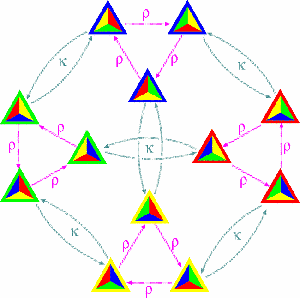
The group of symmetries of a tetrahedron |
(formerly the second half of Math 330)
|
Rings are algebraic structures which encode abstract arithmetic.
A field is a special kind of ring with a particularly rich algebraic structure. The rational numbers, the real numbers, and the complex numbers are examples of fields. Field theory reveals important limitations to mathematical methods. For example:
Field theory is also crucial to modern algebraic geometry (Math 437H). Algebraic geometry originally developed as the study of algebraic varieties (curves and surfaces) defined by polynomials over the field of complex numbers. However, many of the key ideas of algebraic geometry can be extended to abstract fields such as the p-adic numbers, which leads to important insights in modern number theory (e.g. the proof of Fermat's Last Theorem).
|

A ring epimorphism from Z into Z/3 |
Introduction to the concepts, techniques and applications of linear programming and discrete optimization, Topics include the simplex method, duality, game theory and integer programming.
- Prerequisite: Math 1350H.
- Class Timetable: Fall
- Instructor: Marcus Pivato
- Three hours of lectures weekly.
- For more information, please see the MATH 3350H homepage.
This course has been replaced with MATH-COIS 3350H[335H] , MATH 3510H[351H] , and or MATH 3610H[361H] .
Introduction to mathematical theory and computational techniques for pricing financial derivative contracts: forwards, futures and options. Topics include: hedging and risk management, arbitrage, European and American options, bonds and interest rate derivatives, stochastic calculus, binomial and Black-Scholes models, numerical methods.
- Prerequisite: Math 1550H and Math 2050H.
- Class Timetable: Fall
- Instructor: Nikolai Dokuchaev
- Three hours of lectures weekly.
- For more information, please see the MATH 3610H homepage.
This course has been replaced with MATH 2560H[256H] in the fall semester, and with either MATH 3560H[356H] or MATH 3570H[357H] during the winter semester.
Linear regression and correlation, multiple regression, analysis of variance and experimental designs. Assumes a background in probability and uses introductory linear algebra.
- Prerequisite: MATH 2560H[256H] .
- Strongly recommended: MATH 1350H[135H] .
- Class Timetable: Not offered
- Instructor: Not offered
- Three hours of lectures weekly.
- For more information, please see the MATH 3560H homepage.
This course covers a variety of important models used in modeling of random events that evolve in time. These include Markov chains (both discrete and continuous), Poisson processes and queues. The rich diversity of applications of the subject is illustrated through varied examples.
- Prerequisite: MATH 1550H[155H] .
- Class Timetable: Fall
- Instructor: Michelle Boue
- Three hours of lectures weekly.
- For more information, please see the MATH 3570H homepage.
Introduction to the concepts, techniques and applications of discrete optimization. Topics include transportation problems, assignment problems, matchings in graphs, network flow theory and combinatorial optimization.
- Prerequisite: Math 1350H and Math-COIS 2600H.
- Class Timetable: Fall
- Instructor: Bing Zhou
- Three hours of lectures weekly.
- For more information, please see the MATH 3610H homepage.
|
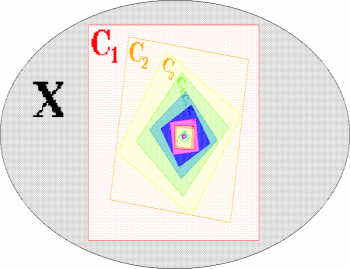
The Chinese Box Theorem says: if A1 > A2 > A3 > .... is a descending sequence of compact sets, then their common intersection is nonempty. This implies that every contraction mapping on a compact space has a fixed point. |
It is easy to generalize to metric spaces the familiar topological concepts of Euclidean space, such as like open sets, closed sets, convergent sequences, continuous functions and compactness, which perhaps you previously encountered in MATH 1100[110] , MATH 2110H[201H] , or MATH 3790H[309H] . We can then prove generalized versions of key results like the Bolzano-Weierstrass Theorem and the Heine-Borel Theorem, and also powerful new results like the Baire Category Theorem. One key application of this theory is the Contraction Mapping Theorem, which can be used to find fixed points of dynamical systems and to identify solutions to many important differential equations.
A topological space does not have a concept of `distance', but still has a structure which encodes the concept of `convergence'. This is important because many natural and important spatial structures cannot be represented using a metric. For example, the most `natural' kind of convergence for a sequence of functions is pointwise convergence, but pointwise convergence cannot be represented using a metric. Also, in algebraic geometry (MATH 4370H[437H] ), the Zariski topology is important for studying the geometry of algebraic varieties.
Another important concept in topology is that of connectedness and the closely related notion of homotopy. A space is connected if it cannot be split into two `separate pieces'. Two spaces are homotopic if one is just a `deformed' version of the other. These concepts form the foundations for an important area of mathematics called algebraic topology (MATH 4330H[433H] ), which studies the `global' properties of topological spaces using group theory.
- Prerequisite: MATH 2120H[202H] and MATH 2200H[220H] ; and one of MATH 3720H[302H] , MATH 3770H[307H] , or MATH 3790H[309H] .
- Meetings: Three lectures and one seminar weekly.
- Class Timetable: Winter
- Instructor: Reem Yassawi
- For more information, please see the MATH 3700H homepage.
Description:
Differential geometry was developed in the 19th century (mainly by Carl Friedrich Gauss and Bernhard Riemann) to study the geometry of smooth curves and surfaces in 3-dimensional space, using the methods of multivariate calculus. Indeed, the ideas and methods you learn in MATH 2120H[202H] are all special cases of this more general theory.
A differentiable manifold is a topological space which generalizes the intuitive notion of a curve or surface. Intuitively, an n-dimensional manifold is a self-contained `universe' which locally `looks like' Rn. This means that we can study the geometry of a manifold near any point by `approximating' the manifold with a vector space (called a tangent space) near that point. Likewise, if f:M --> N is a function between two manifolds, we can study the geometry of f by approximating f with a linear function between their tangent spaces. This linear approximation is called the derivative of f; if f can be adequately approximated in this way, then f is called differentiable. For example, the Euclidean space Rn is a differentiable manifold, and a function f:Rm --> Rn is differentiable in the aformentioned sense if and only if it is differentiable in the sense you learned in multivariate calculus.
Differential geometry is the study of differentiable manifolds and the differentiable functions between them. It is thus a vast and powerful generalization of multivariate differential calculus, which can be applied to abstract multidimensional spaces. Differential geometry is beautiful for its own sake, but is also of critical importance to other areas of mathematics, including the qualitative theory of ordinary differential equations (also known as ``smooth dynamical systems theory'') and modern mathematical physics (in particular, Einstein's General Theory of Relativity and all of its descendants). Differential geometry is a key area of contemporary mathematical research, and is highly relevant to any student entering graduate studies in pure mathematics, applied mathematics, or mathematical physics.
While concentrating on the classical differential geometry of curves and surfaces in 3-dimensional space, this course will also develop the intuitions and concepts necessary to understand the geometry of abstract manifolds. The philosophy of differential geometry is to study smooth objects through linear approximations; hence the curriculum also includes advanced linear algebra such as multilinear functions and tensor calculus.
Rough Syllabus:
- Calculus in Euclidean Space; Tangent Vectors. Vector Fields; Directional derivatives. Curves in R3.
- Linear 1-forms. Differential Forms. Smooth mappings.
- Dot products; orthogonal frames. Curves. The Frenet Formulas.
- The Frenet Formulas. Covariant Derivatives. Surfaces in R3.
- Patch Computations. Differentiable functions. Tangent vectors.
- Differential forms on surfaces. Smooth Mappings.
- Integration of Forms; Stokes' Theorem. Topological Properties of surfaces.
- Differentiable manifolds. The shape operator of a surface.
- Normal curvature. Gaussian & Mean Curvature. Computational techniques.
- Special curves in a surface. Frame fields; Connection 1-forms
- Cartan structure equations. The Fundamental Equations. Form computations. Local Isometries.
- Theorema Egregium.
- Time permitting: Introduction to (pseudo)Riemannian geometry, Einstein manifolds, Simplectic geometry, and/or Hamiltonian manifolds.
- Probable Text: Elementary Differential Geometry (3rd edition) by Barrett O'Neill
- Prerequisite: MATH 2120H[202H] , MATH 2200H[220H] , and MATH 2350H[235H]
- Meetings: Three lectures and one tutorial weekly.
- For more information, please see the MATH 3720H homepage.
- Class Timetable: Not offered
- Instructors: Not offered
(formerly Math 306H)
|
 Colour-coding the complex plane in polar coordinates 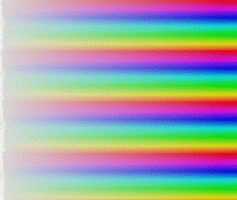 The complex exponential map, seen through this colour-coding. |
- Corequisite: MATH 2110H[201H] .
- Meetings: Two lectures and one tutorial weekly.
- Class Timetable: Fall
- Instructor: Reem Yassawi
- For more information, please see the MATH 3770H homepage.
(formerly Math 206H)
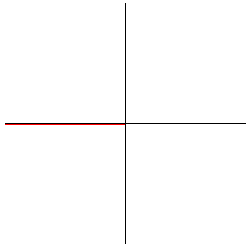 A sequence of successively higher order Taylor polynomials converge to the sine function. |
The real number system. Limits. Continuity. Differentiability. Mean-value theorem. Convergence of sequences and series. Uniform convergence.
|
This course has been split into MATH 3810H[381H]
and MATH 3820H[382H] .
(The first half of the former Math 380)
This course traces the historical development of mathematics from prehistory to medieaval times, and the interactions between the development of mathematics and other major trends in human culture and civilization. We will study the mathematics of ancient Egypt and Mesopotamia, and classical Greece and Rome.
- Prerequisites: MATH 1100[110] .
- Recommended Prerequisite: MATH 2200H[220H] and MATH 2350H[235H] .
- Suggested Corequisite: AHCL 100 (The History of Greece). This corequisite is for student interest only, and is not required.
- Note: This course is logically independent of MATH 3820H[382H] neither one requires the other as a prerequisite.
- Meetings: Three hours weekly.
- Class Timetable: Fall
- Instructor: Stefan Bilaniuk
- For more information, please see the MATH 3810H homepage.
(The second half of the former Math 380)
This course traces the development of mathematical ideas, abstraction and proofs. The genesis of modern arithmetic in mediaeval India, the birth of algebra in the Islamic world, and their influence mediaeval European mathematics. Renaissance mathematics (polynomial equations, analytic geometry). The Enlightenment (calculus, number theory). The apotheosis of rigour since the 19th century.
- Prerequisites: MATH 1100[110] .
- Recommended Prerequisite: MATH 2200H[220H] and MATH 2350H[235H] .
- Suggested Corequisite: HIST 120 (Western European History from the Middle Ages to the present). This corequisite is for student interest only, and is not required.
- Note: This course is logically independent of MATH 3810H[381H] neither one requires the other as a prerequisite.
- Meetings: Three hours weekly.
- Class Timetable: Not offered
- Instructor: Not offered
- For more information, please see the MATH 3820H homepage.
| 1000-Level | ....... | 2000-Level | ....... | 3000-Level | ....... | 4000-Level |

